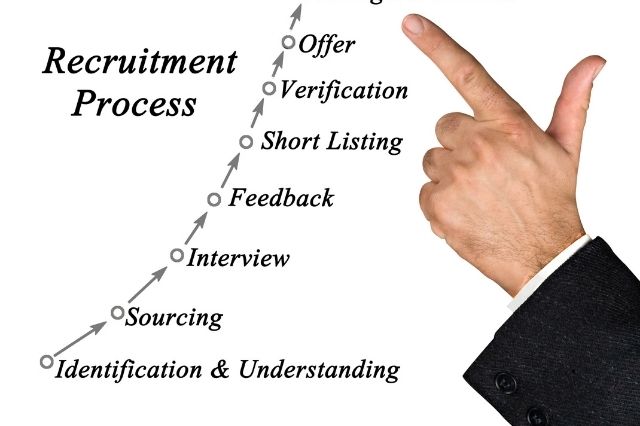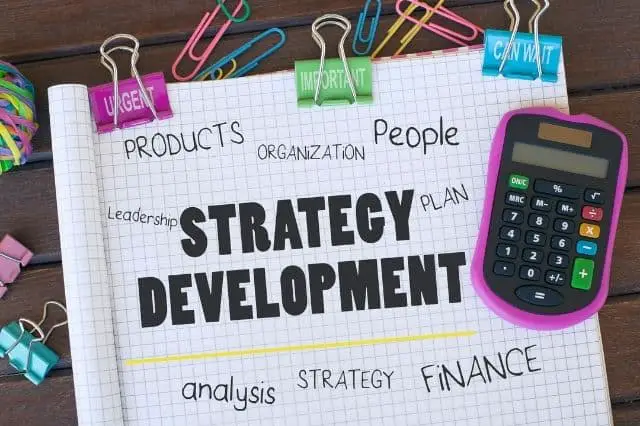Process of Recruitment
Recruitment refers to the process of identifying and attracting job seekers so as build a pool of qualified job applicants. The process comprises five related stages, viz (a) planning, (b) strategy development, (c) searching, (d) screening, (e) evaluation and control.
The ideal recruitment program is the one that attracts a relatively larger number of qualified applicants who will survive the screening process and accept positions with the organization when offered. Recruitment programs can miss the ideal in many ways: by failing to attract an adequate applicant pool, by under/overselling the firm, or by inadequately screening applicants before they enter the selection process.
Thus, to approach the ideal, individuals responsible for the recruitment process must know how many and what types of employees are needed, where and how to look for individuals with the appropriate qualifications and interests, what inducements to use (or avoid) for various types of applicant groups, how to distinguish applicants who are unqualified from those who have a reasonable chance of success, and how to evaluate their work.
1. Recruitment Planning
The first stage in the recruitment process is planning. Planning involves the translation of likely job vacancies and information about the nature of these jobs into a set of objectives or targets that specify (a) number, and (b) the type of applicants to be contacted.
Number of Contacts: Organizations, nearly always, plans to attract more applicants than they will hire. Some of those contacted will be uninterested, unqualified, or both. Each time a recruitment program is contemplated, one task is to estimate the number of applicants necessary to fill all vacancies with qualified people.
Companies calculate yield ratios (yRs) which express the relationship of applicant inputs to outputs at various decision points. For example, assume that an organization attempting to recruit salespeople ran a series of newspaper advertisements. The advertisement generated resumes from 2000 applicants, of which 200 were judged to be potentially qualified (yR = 10:1). Of these 200, 40 attended the interview for final selection (yR = 5:1). Of these 40, 30 were actually qualified and offered jobs (yR=4:3); and of the 30, 20 accepted (yR = 3:2). In this case, the overall yR is 100: I . Thus, a requirement of 30 hires, during a specified period, would mean a recruitment target of 3000.
The yRs must be used with circumspection. No yRs will be available for recruiting employees for the first time, or for recruiting sources or methods that have not yet been tried. Recruiters in such cases have to depend upon their counterparts in other organizations or make their own guesses.
Type of Contacts: This refers to the type of people to be informed about job openings. The type of people depends on the tasks and responsibilities involved and the qualifications and experience expected. These details are available through the job description and job specification.
2. Strategy Development
Once it is known how many and what type of recruits are required, serious consideration needs to be given to (a) make or ‘buy’ employees; (b) technological sophistication of recruitment and selection devices; (c) geographic distribution of labor markets comprising job seekers; (d) sources of recruitment; and (e) sequencing the activities in the recruitment process.
‘Make’or ‘Buy’: Firms must decide whether to hire less-skilled employees and invest in training and education programs, or they can hire skilled labor and professionals. Essentially, this is the ‘make’ (hire less-skilled workers) or ‘buy’ (hire skilled workers and professionals) decision. Organizations that hire skilled labor and professionals shall have to pay more for these employees.
‘Buying’ employees have the advantage in the sense that the skilled labor and professionals can begin the work immediately and little training may be needed. But the high remuneration that the skilled workers and professionals demand may outweigh the benefits.
Technological Sophistication: The second decision in strategy development relates to the methods used in recruitment and selection. This decision is mainly influenced by the available technology. The advent of computers has made it possible for employers to scan national and international applicant qualifications. Although impersonal, computers have given employers and job seekers a wider scope of options in the initial screening stage.
Technological advancement has made it possible for job seekers to gain better access. They have begun sending videotapes about themselves to a number of companies without wasting time and without spending money on travel.
Where to Look: In order to reduce costs, firms look into labor markets most likely to offer the required job seekers. Generally, companies look into the national market for managerial and professional employees, regional or local markets for technical employees, and local markets for clerical and blue-collar employees.
In the final analysis, organizations recruit where experience and circumstances dictate likely success. Recognizing this, many adopt an incremental strategy in which initial efforts are concentrated in regional or local labor markets and expanded only if these efforts fail to achieve the desired results.
How to Look: How to look refers to the methods of sources of recruitment. There are several sources and they may be broadly organized into (a) Internal, and (b) External
Internal recruitment seeks applications for positions from those who are currently employed. Internal sources include present employees, employee referrals, former employees, and former applicants.
External sources far outnumber the internal methods. Specifically, sources external to a firm are professional or trade associations, advertisements, employment exchanges, college/university/institute placement services, walk-ins and write-ins, consultants, contractors, displaced persons, radio and television, acquisitions and mergers, and competitors.
3. Searching
Once a recruiting plan and strategy are worked out, the search process can begin. The search involves two steps (i) source activation and (ii) selling.
Source Activation: Typically, sources and search methods are activated by the issuance of an employee requisition. This means that no actual recruiting takes place until line managers have verified that a vacancy does exist or will exist.
If the firm has planned well and done a good job of developing its sources and search methods, activation soon results in a flood of applications and/or resumes.
The applications received must be screened. Those who pass have to be contacted and invited for an interview. Unsuccessful applicants must be sent letters of regret.
Selling: A second issue to be addressed in the searching process concerns communications. Here, organizations walk a tightrope. On one hand, they want to do whatever they can to attract desirable applicants. On the other, they must resist the temptation of overselling their virtues.
In selling the company, both the message and the media deserve attention. The message refers to the employment advertisement. With regard to media, it may be stated that the effectiveness of any recruiting message depends on the media. Media are several-some have low credibility, (employment exchanges, for example) while others enjoy high credibility (advertisements in business magazines, for example). Selection of medium or media needs to be done with a lot of care.
4. Screening
Screening of applications can be regarded as an integral part of the recruiting process, though many view it as the first step in the selection process. Even the definition of recruitment excludes screening from its scope. However, screening is included in recruitment for valid reasons. The selection process will begin after the applications have been scrutinized and shortlisted.
The hiring of professors at a university is a typical situation. Applications received in response to advertisements are screened and only eligible applicants are called for an interview. The interview is conducted by a selection committee comprising the Vice-Chancellor, Registrar, and subject experts. Here, the recruitment process extends up-to screening the applications. The selection process commences only later.
The purpose of screening is to remove from the recruitment process, at an early stage, those applicants who are visibly unqualified for the job. Effective screening can save a great deal of time and money. Care must be exercised, however, to assure those potentially good employees are not lost and that women and minorities receive full and fair consideration and are not rejected without justification.
In screening, clear job specifications are invaluable. It is both good practice and a legal necessity that applicants’ qualifications be judged on the basis of their knowledge, skills, abilities, and interests required to do the job.
The techniques used to screen applicants vary depending on the candidate sources and recruiting methods used Interviews and application blanks may be used to screen walk-ins. Campus recruiters and agency representatives use interviews and resumes. Reference checks are also useful in screening.
5. Evaluation and Control
Evaluation and control are necessary as considerable costs are incurred in the recruitment process. The costs generally incurred are:
1. Salaries for recruiters.
2. Management and professional time spent on preparing job descriptions, job specifications, advertisements, agency liaison, and so forth.
3. Cost of advertisements or other recruitment methods, that is, agency fees.
4. Cost of producing supporting literature.
5. Recruitment overheads and administrative expenses.
6. Costs of overtime and outsourcing while the vacancies remain unfilled.
7. Cost of recruiting suitable candidates for the selection process.
Questions should always be asked as to whether the recruitment methods used are valid and whether the recruitment process itself is effective.
Statistical information on the cost of advertisements, time is taken for the process, and the suitability of the candidates for consideration in the selection process should be gathered and evaluated. However, exercises seem to be seldom carried out in practice.
6. Evaluation of Recruitment Process
The recruitment process has the objective of searching for and obtaining applications from job-seekers in sufficient numbers and quality. Keeping this objective in mind, the evaluation might include:
1. Return rate of applications sent out.
2. Number of suitable candidates for selection.
3. Retention and performance of the candidates selected.
4. Cost of the recruitment process.
5. Time lapsed data.
6. Comments on image projected.
 Evaluation of Recruitment Methods
Evaluation of Recruitment Methods
The evaluation of recruitment methods might include:
1. Number of initial inquiries received which resulted in completed application forms.
2. Number of candidates at various stages of the recruitment and selection process, especially those shortlisted.
3. Number of candidates recruited.
4. Number of candidates retained in the organization after six months.










